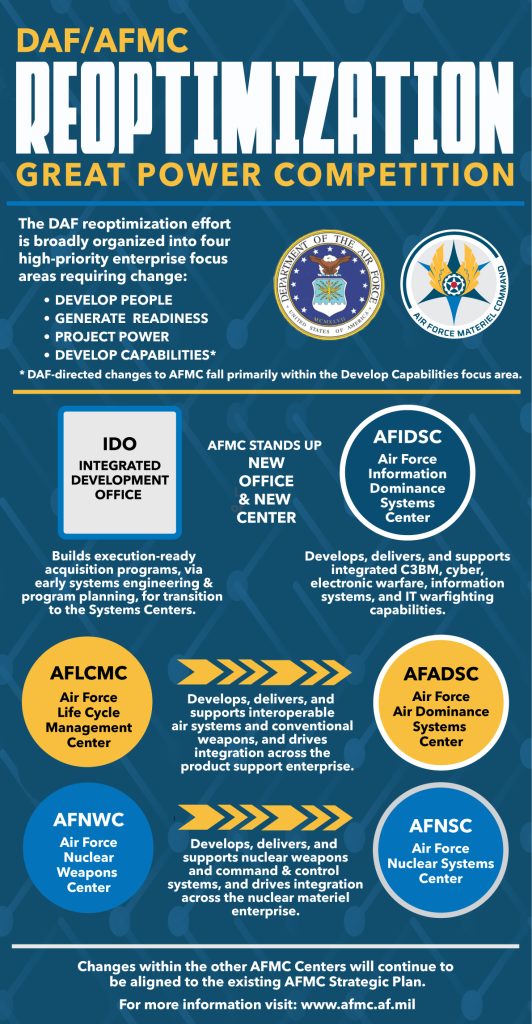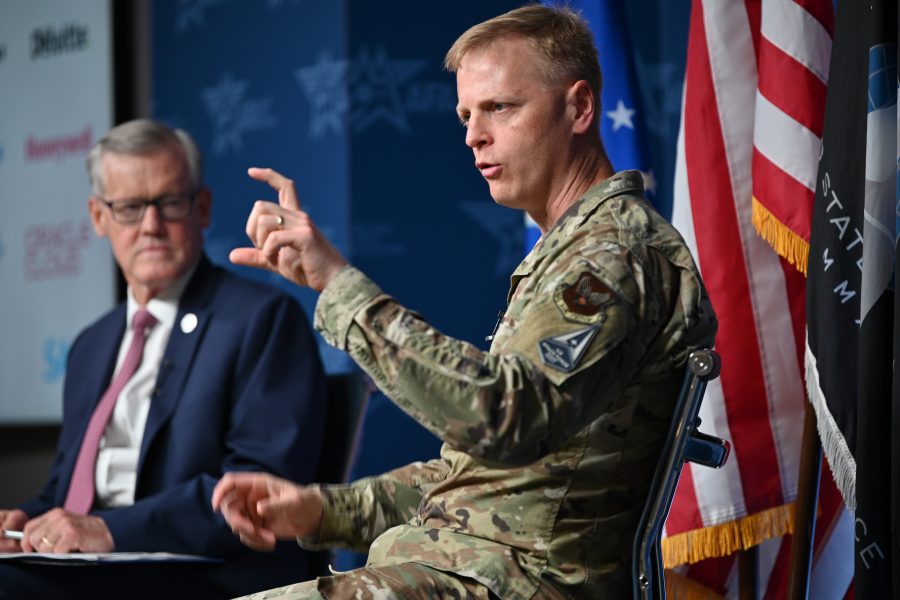Editor’s Note: This story was updated April 9 with additional details.
Brig. Gen. Luke C.G. Cropsey—or his successor as the Department of the Air Force’s top command, control, and communications/battle management officer—will command the new Air Force Information Dominance Systems Center, Air Force Materiel Command announced April 4.
An AFMC spokesperson told Air & Space Forces Magazine the goal timeline for standing up the center is mid- to late-2025.
The command also said it will elevate its director of aircraft propulsion to a program executive officer, and will split the PEO now responsible for mobility and trainer aircraft systems into separate jobs.
The changes are part of the department’s effort to “re-optimize for great power competition.”
AFMC’s announcement offers some of the first specifics since the re-optimization changes were unveiled in February. The Information Dominance Systems Center will cover a broad range of nonkinetic capabilities, including C3/BM, cyber, electronic warfare, digital infrastructure, and more.
The center’s commander will be Department of the Air Force’s PEO for C3/BM, the job Cropsey has held since September 2022. Cropsey is the first ever in the position, which Air Force Secretary Frank Kendall and service acquisition executive Andrew Hunter created to tie together the department’s disparate efforts to develop joint all-domain command and control and the Advanced Battle Management System.
Kendall has called Cropsey’s position “the hardest acquisition job I’ve ever given anybody.” Cropsey, in turn, has taken what he calls a “model-based system engineering approach” to simplify his mission, starting by defining some of the basic digital infrastructure needed to connect sensors and shooters around the globe.
The Information Dominance Systems Center will also absorb three PEOs from the Air Force Life Cycle Management Center, while tweaking some of their portfolios:
- PEO for Command, Control, Communications, Intelligence, and Networks will become PEO Cyber and Networks, with a revised portfolio. Maj. Gen. Anthony Genatempo is the current PEO.
- PEO Digital will become PEO Electronic Systems, with a revised portfolio. Col. William T. Collins Jr. is the acting PEO.
- PEO Business Enterprise Systems will stay the same.
The Life Cycle Management Center will become the Air Force Air Dominance Systems Center and drop to nine PEOs, four of which—bombers; fighters and advanced aircraft; armament; Presidential and Executive airpower—will remain largely unchanged. The move to split mobility and trainer aircraft under two PEOs comes as the Air Force embarks on a major shift in its tanker fleet, acquiring an undetermined new “bridge” tanker to complement the KC-46 and developing a Next-Generation Aerial refueling System (NGAS), which could have stealthy characteristics, to answer combat requirements in the Pacific.
Meanwhile, the new T-7 trainer has suffered a series of delays.
Making the top propulsion official a PEO shifts the platform-centered focus that has defined engine development in the past to a more “holistic, integrated” approach, the AFMC statement said. Right now, the Life Cycle Management Center’s propulsion directorate is led by director John Sneden. The new PEO will have to guide the nascent Next-Generation Adaptive Propulsion program that will power the Next-Generation Air Dominance fighter and will likely play a key role in developing engines to go on different Collaborative Combat Aircraft variants.
The Rapid Sustainment directorate, currently led by the Life Cycle Management Center commander, will take over some programs from the Agile Combat Support directorate and become the combat readiness directorate, led by the Air Dominance Systems Center commander. The ISR and Special Operations Forces directorate will also take on additional programs, including the E-3 AWACS, E-7 Wedgetail, E-8 JSTARS, and E-9.
AFMC’s Air Force Nuclear Weapons Center will be renamed the Air Force Nuclear Systems Center and headed by a three-star general, who will also be PEO for “Nuclear Air Delivered Systems and the Nuclear Materiel Manager for the DAF.” Under that command will be the new PEO for intercontinental ballistic missiles along with the existing PEO for nuclear command, control, and communications.
Finally, AFMC is establishing its new Integrated Development Office, which will “be responsible for defining and overseeing early systems acquisition prototyping, experimentation, and mission engineering; executing enterprise-focused and integrated early systems engineering and systems acquisition; and applying the technical architectures developed and managed by the three Systems Centers,” AFMC said in a statement.
The office will be coordinate closely with the new Washington-based Integrated Capabilities Command, a three-star major command set to reach initial operating capability this year with the role of setting requirements and structuring the force of the future.
“More information will be released as plans are confirmed, but the intent is to move forward as quickly as possible,” AFMC said. Service leaders have repeatedly said they intend to minimize personnel movements related to the changes.

